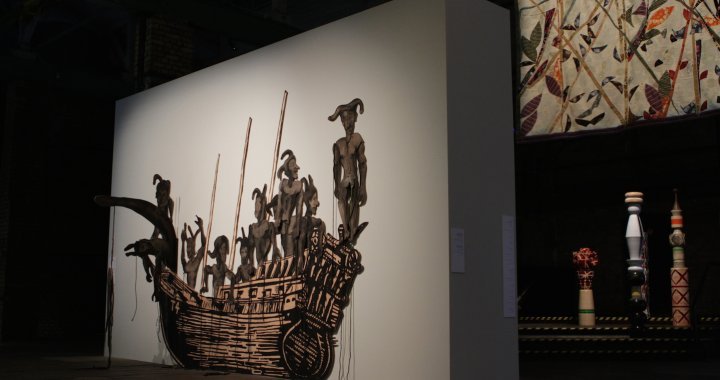
A sandbox for all
On the Dreams and Dramas exhibition at the Zuzeum Art Centre
28/10/2017
Standing near the doors of the Zuzeum on the evening of the opening of the exhibition, among the surrounding chatter I listened as a young artist voiced her opinion on what she had just seen. As I recall, her main verdict was along the lines of: “Well, the works are great, but I don’t think that the locals will understand their mentality.” I didn’t manage to find out what specific mentality she was referring to, nor what was supposedly so incomprehensible or strange about it, but I decided that perhaps it had something to do with the “intensity”, “energy”, “vitality”, “directness”, and other attributes and descriptors for Israel used in the exhibition’s publicity materials. Being “a local”, I felt a natural defensiveness in hearing that my ability at comprehension was being questioned, but I didn’t say anything at the time because, well, who knows, maybe that's how it is. Having awaited Sunday, I headed to the new exhibition space once again to see everything in an air of peace and quiet, and to fully assess my true levels of comprehension. On the way there, I thought about what I had heard the previous evening, and reviewed what my mind had stored away in the file titled “Israel”. Truth be told, there wasn’t much: a Jewish state, a bloody history, a few geographical facts, a few famous people, the site of some of the most important landmarks of Western cultural history, and a scattering of unclear impressions and associations. And, intentionally or not, a confounding political aftertaste that the news media bolster on a daily basis: ongoing conflict in the region...humanitarian conditions in the Palestinian and Gaza territories...hate between Jews and Arabs...Israel as occupier...and Israel as trustworthy ally etc.
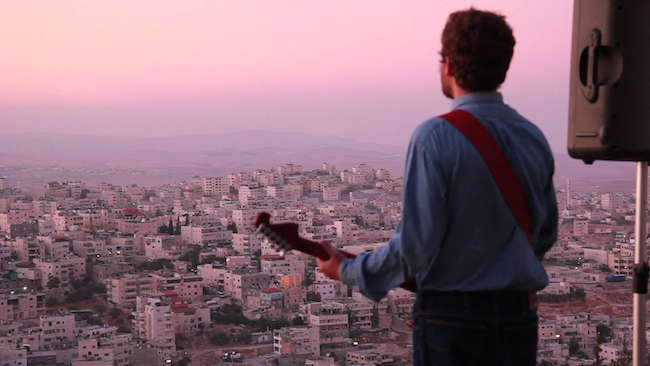
Daniel Kiczales. The Messenger, 2011. Video, 18’
All of these thoughts and attempts at getting into the right mindset instantly disappeared, however, before I had even actually entered the exhibition space – the noise coming from within had unexpectedly surprised me. Only now, when the space contained only a couple of other people besides me, could I hear how loud the soundtrack to Daniel Kiczales’ video work The Messenger actually was. The otherworldly adhan, the Muslim call to prayer blared from unseen minarets, filled the former factory space and equalized the disproportionate tension between the visitor just entering the space and the exhibition’s electrically mellow atmosphere, immediately making the visitor feel like an organic part of the room. Although several of the exhibited works feature sound, The Messenger absolutely dominates in this sense, and it completely banished any and all thoughts of differing mentalities and such. As someone who has never followed such a call to prayer, I heard in the music something that is, if not universally humanistic, then at least surprisingly close to me personally. Whether it was the universally human desire to seek the metaphysical, or simply pleasant associations with documentary films on the Middle East I had seen long ago, I’m not sure. Whatever it was, it made me sit down across from the wall upon which The Messenger was being projected, and feel as if I had been sitting there for years. After a while, the “messenger” standing on top of the hill begins to play his electric guitar; the chords, which just as well could have been played by David Gilmour at some open-air concert, symbiotically merge with the cantillating voice and, once again, I am astounded. These two instruments, coming from such disparate worlds, play off of one another so organically that one could assume that they have rehearsed it many times; as I later find out, they haven’t. The village saturated with the sound of the mu’addhin’s voice is located in the occupied part of Palestine, while the guitarist looks down on it from a hill on which stands a prestigious Israeli art school. Nevertheless, somehow they find each other. Of course, it would be overly simplistic to label this as Eastern/Western unity, the breaking down of borders, an opportunity to “be as one”, and so on. Kiczales’ piece also speaks about the two sides’ irreconcilability (the guitar is, in a sense, committing assault, since the mu’addhin is unaware that his singing is being “supplemented”). In any case, as I sat in the darkened space of the Zuzeum listening to the “jam session” of voice and guitar, I was quite convinced that, at least here, there is no need to get carried away with thinking about possible differences in mentality.
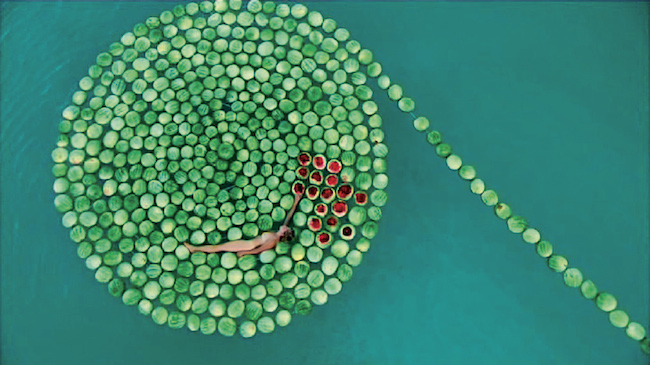
Sigalit Landau. DeadSee, 2005 Video, 11:39 min. loop. Courtesy of the artist
Roy Brand, the curator of the exhibition, said in his interview with Arterritory that the works were created and selected so that they would have a sense of a specific culture and place, but at the same time, could be understood by everyone. I have no reason to doubt this, but the works from Dreams and Dramas that I had the most affinity for were the ones that turned this notion on its head: first and foremost, they could be understood by all; only as an afterthought would one, perhaps, notice a specific reference to a place or time, or, if so inclined, to a culture. Of course, Sigalit Landau’s wonderfully sensory collaboration with the Dead Sea, set out in the very center of the space, dictates a clear scale of time and place for everything else, but in the other works, this link seems to be expressed as something incidental – not defining. One doesn’t have to know anything about Hasidism to have the existentially distressing, scrawled silhouettes of Porat Salomon remind one of the bottomless depths in one’s own daily existence. One doesn’t have to know anything about the history of the Israeli-Palestinian conflict to empathize with the grandmother in Dor Guez’s video story Sabir. There’s something primitively alluring about the raised hands of Sagit Mezamer’s Mother of Opium, and even Guy Zagursky’s reclining rhinoceros (life-size, right?) encourages one to take a friend by the hand and sit down next to the animal, backs pressed up against its massive flank.

Nir Hod. The Life We Left Behind I. 2016. Oil paint under chromed canvas. 229 x 159 cm
This gathering of works by Israeli artists has filled the building on Lāčplēša iela with art that, for the most part, does not preoccupy itself with multilayered meanings and intricate interpretations. They are straightforward and open, and allow the viewer to connect with them immediately, almost without any additional conceptual mediation. The visitor enters Israel almost in a geographical sense, as the walls on the opposite ends of the space feature projections of the videoworks Sabir (Guez) and The Messenger (Kiczales) – stories that take place on two opposite sides of Israel, namely, the Mediterranean coast and Palestine. The area in the middle of the room is like a sandbox in which all the step-children of this much-suffered land can play, while the surrounding abstract paintings of Nir Hod and Marik Lechner seem to take tally of the cuts and bruises acquired by these step-children as they play. In Dreams and Dramas, modern-day Israel, which we often think about in black-and-white categories, reveals to our eyes much more colorful and intricate facets of itself; in addition, one gets the sense that even these impressions refer to only the visible part of the iceberg. Indeed, many of the works are inevitably imbued with a political-religious tension, and undoubtedly, that is the main dimension of discussion when it comes to the region’s most specific characteristics. However, most of the fourteen artists showing in the exhibition are young in age, and have inherited the situation – not created it. Coming into contact with something that is not of your doing, but which must, nevertheless, be dealt with, can elicit a variety of reactions – from resignation to rebellion – and they can all be seen here. One reaction, however, seems more present than the rest – tranquil reflection which is, at the same time, a condition permeated with watchful readiness. The clothing that Landau has stiffened in the waters of the Dead Sea; the back-and-forth switching of languages in Sabir; and the messianic creature in Keren Yeala Golan’s Nomina, which seems to embody both Jesus and Venus – they are all infused with a serious and relentless stare that is on the outlook for new roads, new languages, new opportunities for understanding, and on this quest, they are not afraid of veering from the specific to the universal. The world of binary opposition and enemy camps is left in the background, much like Terrorist Head (a sculpture by Erez Israeli), which, even though it’s lying in the middle of the room, is noticed only when you’ve already almost tripped over it.
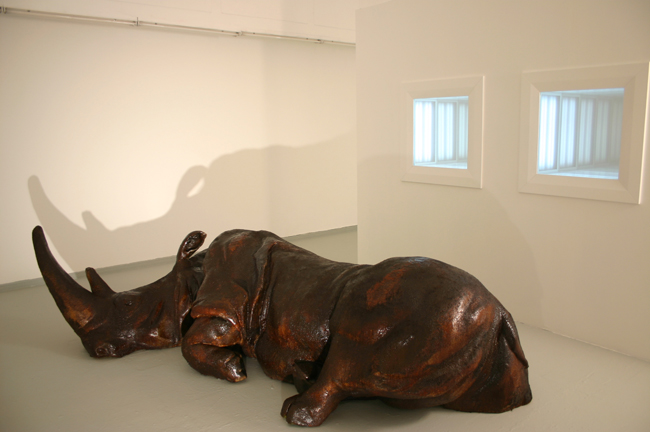
Rhinoceros, 2004. Mixed media. 320 x 80 x 100. Courtesy of the artist and Sommer Contemporary Art, Tel Aviv
Both of these – the searchings for the universal and the directness of the works – make them comprehensible, and my aforementioned fears about differences in mentality have vanished as if they had never existed. Moreover, it doesn’t seem at all appropriate in this case to use such a heavy concept as comprehension or understanding – as I already mentioned, the mind’s (conceptual) mediation often becomes secondary, or even disappears altogether. These works by young Israeli artists are somehow easy “to take possession of” – to make them at least partly your own as you finding something endearing or familial in them. Much like in a dream when, surrounded by strange objects, you can suddenly feel completely at home. And this is when it first dawns on me – perhaps these dreams of the exhibition’s title are actually a reference to the other definition of dreams. Sabir ends with these mysterious words by Dor Guez’s grandmother: “I dreamt more when I was younger.”
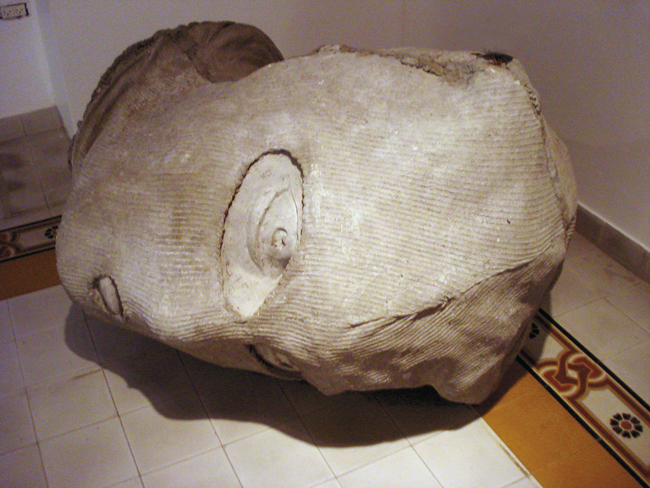
Terrorist Head, 2007. Concrete casting, 120 x 100 x 80. Courtesy of Gallery Givon, Tel Aviv
The Dreams and Dramas exhibition is a special project for Riga initiated and funded by the Riga-born businessman, collector, and patron of the arts, Leon Zilber.
The exhibition is ongoing at the ZUZEUM Art Centre through November 5.
Exhibition hours:
M: Closed
Tue – Th: 12:00-18:00
F – Sat: 12:00-20:00
Sun: 12:00-18:00
Guided tours:
Sat: 12:00, 15:00 / Sun: 12:00